


|
| Periodontal disease is caused mainly by the accumulation of bacteria (plaque). The destructive toxins and enzymes produced by these bacteria cause the gum tissues to detach and separate from the tooth, thereby forming a space called the periodontal pocket. Bacterial plaque continues to collect in these pockets, causing them to deepen and destroy the underlying supporting tissues. See fig. 1 and fig. 2 | |
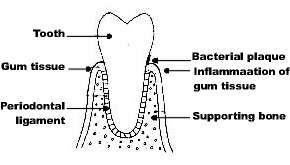 fig.1 | 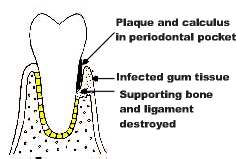 fig.2 |
| The purpose of the periodontal examination is to determine the extent of the disease by carefully measuring the amount of periodontal pocket formation, supporting bone loss, and tooth mobility. Factors contributing to the disease process such as faulty biting relationships between opposing teeth, plaque accumulation, and defective restorations (fillings) are noted and recorded. X-rays are evaluated and a plan of treatment is devised with the purpose of eliminating the causes of the disease. The objective of periodontal treatment is to reduce the depth of the pocket so that the tooth surface can be kept free of plaque. See fig.3 and fig. 4 The most important phase of any treatment is the maintenance done by you--the patient. Any treatment is doomed to failure without adequate home care, which includes brushing, flossing and the use of any other devices that are recommended. | |
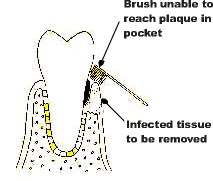 fig.3 | 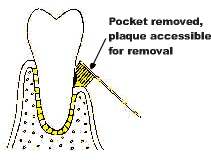 fig.4 |
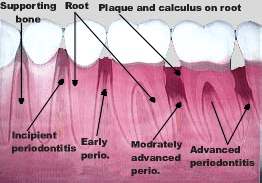
| As the disease process becomes more advanced the supporting bone around the roots of the teeth is resorbed . As the severity of the disease continues the result would be loosening of the teeth, with their eventual lose. |

|
Periodontal disease is an infection caused by bacteria so it should not be surprising that it can be a contributing factor to other diseases and conditions of the body.
Heart Disease
People with periodontal disease may be more at risk for heart disease, and have nearly twice the risk of having a fatal heart attack than people without periodontal disease.
Periodontal bacteria may enter the bloodstream through inflamed gums and cause small blood clots that contribute to clogged arteries. Another possibility is that the inflammation caused by periodontal disease contributes to the buildup of fatty deposits in coronary arteries.
Diabetes
People with diabetes are more likely to have periodontal disease. Periodontal disease may make it more difficult for people to control their blood sugar. Severe periodontal disease can increase blood sugar, contributing to increased periods of time when the body functions with a high blood sugar level, putting one at an increased risk for diabetic complications.
Respiratory Disease
We kinow that infections in the mouth are associated with an increased risk of respiratory infection. More research is needed to confirm the association of periodontal disease with respiratory diseases.
Pregnancy
Pregnant women who have periodontal disease, along with other contributing factors, are seven times more likely to have a premature or low birthweight baby. All infections are cause for concern among pregnant women because they pose a risk to the health of the baby. Since periodontal disease is easily detected and treated, a periodontal evaluation should be a part of prenatal care.
|